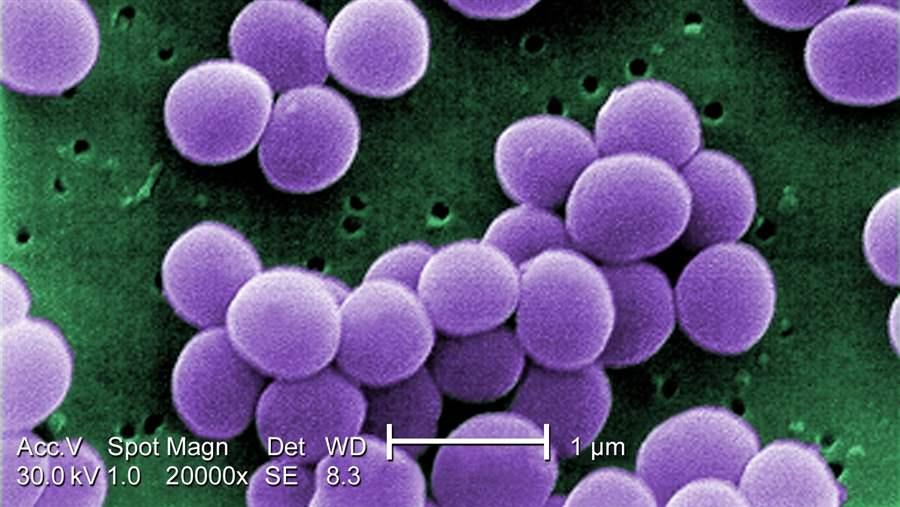Pew Scholar Explores New Approaches to Fighting Staph
Research on ribosomes could yield innovative antibacterial treatments

A scanning electron micrograph shows an antibiotic-resistant strain of Staphylococcus aureus bacteria. Frances Yap’s research is looking for new ways to combat bacterial infections.
Kara ColemanOne of the most essential processes for cell growth and survival is the generation of new proteins to make new cellular structures—a feat catalyzed by ribosomes, the protein factory of the cell. Assembling proteins takes two steps: transcription and translation. Instructions are first transcribed from DNA into messenger RNA (mRNA); the ribosome then reads mRNA and translates the information into protein by linking individual units of amino acids. The process is demanding and energy-consuming, and bacteria have found ways to halt making protein when stressed—such as when they have limited access to nutrients or are under attack from antibiotics—by switching ribosomes into an inactive or hibernating state. This helps them to survive.
Mee-Ngan (Frances) Yap, Ph.D., a 2012 Pew scholar and associate professor at St. Louis University, is researching the fundamental aspects of how bacteria make proteins. Her work, which integrates genetic, biochemical, and genome-wide approaches, was highlighted in the September issue of the journal Nature, in which Yap and colleagues revealed new information about the unique structure of hibernating ribosomes in Staphylococcus aureus (Staph).
Staph is a normal part of body flora, but pathogenic strains can cause skin infections as well as food and blood poisoning. Yap noticed that the structure of these hibernating ribosomes in Staph was distinct compared with other bacteria such as Escherichia coli. She also found that if the ribosomes were unable to switch into a hibernating state, then Staph could not survive well and were less infectious. By hindering the ability of ribosomes to become inactive, Yap may have found a species-specific target for treating Staph infections. Notably, ribosome hibernation is not a permanent process, and once the stressor is removed, Staph goes back to making proteins again and re-engaging in normal function. Yap has also identified the enzyme responsible for “waking up” hibernating ribosomes to make them active again. This work was recently described in an article in the Proceedings of the National Academy of Sciences.
Many antibiotics halt bacterial growth by disrupting different stages of protein production, but microbes will continue to evolve new strategies of defense. Antibiotic resistance remains a large hurdle in treating infections, including those caused by resistant strains such as methicillin-resistant S. aureus. Yap’s findings offer insight into potential new ways to curb bacterial growth.
Kara Coleman directs The Pew Charitable Trusts’ biomedical programs, including the biomedical scholars, Pew-Stewart Scholars for Cancer Research, and Latin American fellows programs.











